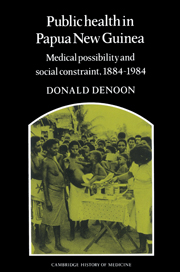Book contents
- Frontmatter
- Contents
- Acknowledgements
- Maps of Papua New Guinea
- Introduction
- I The rise and fall of tropical medicine
- II The rise and fall of the great campaigns
- 8 Miracle drugs, new perceptions and the post-war Public Health Department
- 9 The health campaigns
- 10 Women and children last
- 11 Health education
- 12 A national health system
- 13 Primary health care
- 14 The past and the future
- Notes
- Bibliography
- Index
8 - Miracle drugs, new perceptions and the post-war Public Health Department
Published online by Cambridge University Press: 11 February 2010
- Frontmatter
- Contents
- Acknowledgements
- Maps of Papua New Guinea
- Introduction
- I The rise and fall of tropical medicine
- II The rise and fall of the great campaigns
- 8 Miracle drugs, new perceptions and the post-war Public Health Department
- 9 The health campaigns
- 10 Women and children last
- 11 Health education
- 12 A national health system
- 13 Primary health care
- 14 The past and the future
- Notes
- Bibliography
- Index
Summary
The Pacific War was slow to wind up in New Guinea. Japanese forces – cut off but still able to defend themselves – were harassed by Australian and Papua New Guinean soldiers, while MacArthur drove on to Manila. It was late in 1945 before all surrenders were accepted, all conscript labourers returned home, and most military detachments demobilised. During six years of war (including almost four of direct combat) many features of the 1930s had been obliterated. In particular, the post-war medical administration would be armed with a range of new drugs and animated by new perceptions of medical possibilities. Most obviously, penicillin became available. It was used widely in the armed services but more sparingly among civilians. The first instance of penicillin being used for a civilian's traumas, may have occurred in 1943: a young Milne Bay girl was carried by the missionary Cecil Abel to a military hospital, her arm so badly broken and infected that he thought she would lose it. The medical officer on duty administered penicillin lavishly – Abel was jolted by the unspoken calculation that several hundred pounds' worth of the drug had been administered – and miraculously the girl's arm was saved. Civilian doctors in peace-time were less lavish in prescribing it, at the price which it commanded, but gradually it became cheaper and more accessible.
- Type
- Chapter
- Information
- Public Health in Papua New GuineaMedical Possibility and Social Constraint, 1884–1984, pp. 67 - 76Publisher: Cambridge University PressPrint publication year: 1989



